Amish Scrapple
The skill of slaughtering animals is one now beyond the capacity of most modern folks, though it was once quite common. Many Amish still do kill chickens and other farm animals for food.
A running joke among Amish farmers has something to do with a visitor from the city thinking milk “comes” from a grocery store. Wish I could remember the punchline but the point is that we don’t often think about where our food comes from (and if we did, we might be less inclined to eat it…come to think of it, I just had a hunk of sausage for breakfast this morning…).
My father, on observing milking at an Amish farm, steadfastly refuses any offers of milk from Amish farm friends to this day. His beef was with the cows and their rear ends being in such close proximity to the milk container.
I don’t know that there’s much to worry about, but he’ll take his fully-homogenized-and-pasteurized-in-the-sterile-grocery-store-container and that is THAT, thank you. I must have a shorter memory or am just less dainty about it than pop because I am a regular drinker of the raw stuff.
I also remember happening upon a blood-splattered Amish housewife in the backyard of her home, while selling books in the Nappanee, Indiana Amish community. Thinking at first that I had stumbled into a new genre of film, the Amish horror, I made ready to turn tail in terror. I quickly realized it was just butchering day and there was nothing to worry about. Not pretty, but it’s got to be done.
The Amish Cook column recently featured a bit on author Lovina Eicher’s family butchering of a steer and hogs (don’t worry, it’s light on the gory details–whoops-no longer online). As a bonus you get a recipe for “Pon Hoss”, why I’ve never tried (at least I don’t think I have, but who really knows?) though I have certainly eaten that curiosity popular among Amish, “scrapple”.
If you’ve ever had it, scrapple is a mystery meat whose origins it is probably best remain a mystery. Tastes pretty good though–and that’s what counts, right??
photo credit: Alvegaspar, creative commons



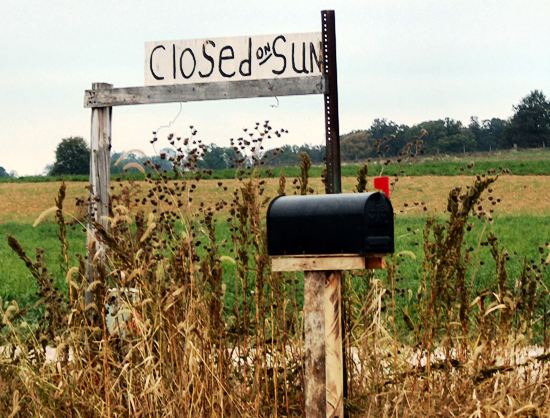
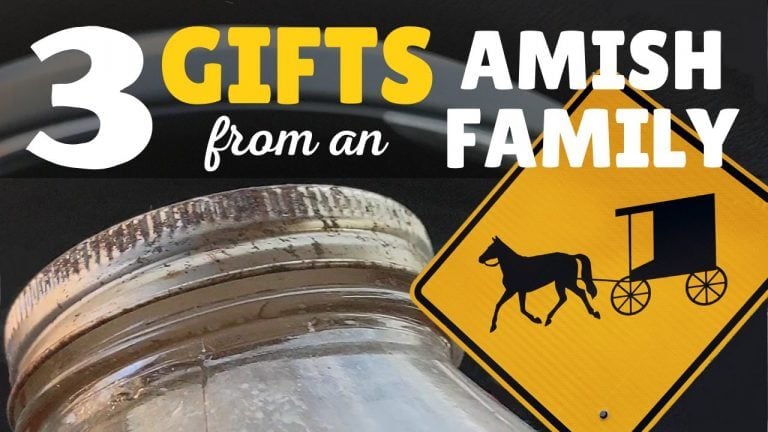
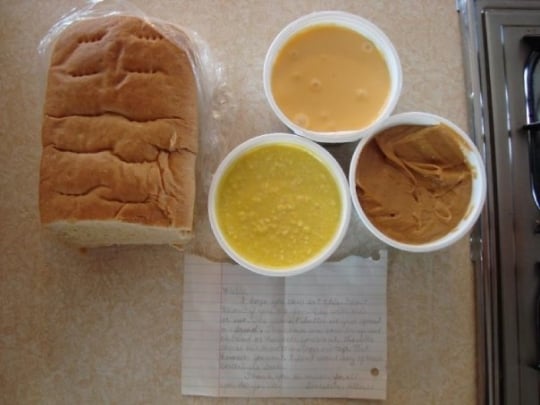

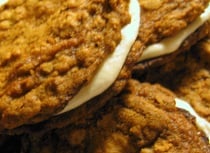

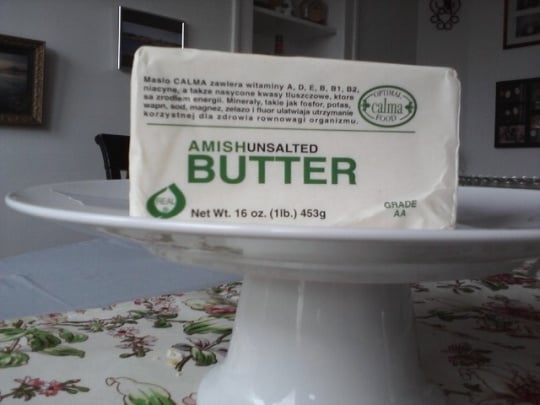
When I hear “hoss”, the first thing I think of is “horse”.
I think Pon Hoss *is* Scrapple. Or at least it’s very, very close. Never cared for it myself, but it has its fans.
My father was from Delaware, and we ate scrapple regularly. He was always a little vague about what was in it. We did used to joke about it looking back at you from the plate, so that should give you some idea…..
I really enjoy reading your essays. Have you visited the Amish settlement in Nathalie, Virginia? It formed from one of the Dover settlements, I think
My relatives all butchered pigs and processed all the meat including curing hams and bacon, grinding sausage and making headcheese or souse, and scrapple. One of my first jobs as a boy was to clean the ears of the pig of hair and wax. These were thrown into a large iron pot along with the skin which was separated from the fat and other meaty pieces, including the heads and sometimes the feet. This meat was cooked until it separated. A strainer fished out the big pieces and the meat cleaned of bones and other non-edible pieces. Then this meat was chopped coarsely, seasoned with spices and poured into molds like a bread pan. There was enough gelatin present to make it set up enough for slicing. Then, we returned to the kettle with another strainer with smaller holes to pull out more meat. This was also seasoned and poured into bread pans. Since the pieces of meat were smaller, they held a lot more grease. This was what we call “panhaus.” There was still liquid in the kettle with very small particle of meat. To this cornmeal and spices mainly sage and black pepper were added and cooked. This then was poured into more molds. This was called “scapple.”
No, I don’t eat scrapple, but I never liked the seasoning or texture, as I’m not squeamish about sausage ingredients. And I loved raw milk as a child, but have such a serious lactose intolerance, that I couldn’t drink it now, although I would like to get some for cheese-making. We can’t buy raw milk in Canada.
As followup to a previous post, we recently drove through Springford, Ontario. It was Monday, and you could tell you were in a conservative Old Order community. The wash was on the line at everyone’s house, and it was all blue, black and white. It was really a very pretty sight, too. I’ll try to have a camera next time we go that way. It looked to be a prosperous little community, very nice farms.
we’ve been fortunate to have a raw-milk source for about 6 years now. I am lactose intolerant, as are 2 of my sons and my husband. To our surprise, raw milk causes no symptoms, probably because it contains lactase already, which is destroyed when processed. Aside from being great to drink, clean, raw milk never ‘goes bad’, it just gradually turns into cheese. No matter how sour it is, I can use it in baking and everything comes out really well. Also made mozzarella cheese with it once, and it was delicious!
I’ve never had raw milk before but I’d try it. I’m used to skim so even whole milk seems “thick” to me, but hey why not!? Also, I’ve had Spam – does that count?? I hear scrapple and think of scraps and my garbage disposal and it’s not pretty. But again, I bet I’d try it – it might be right up my alley.
Tim, thanks for your description–I was simultaneously fascinated and–let’s say horrified for lack of a better word–as I read it! I imagine I will recount this in my head every time I’m faced with a scrapple breakfast from now on…oh well, it’s my own fault for growing up in town I guess!
Forest, thanks for your kind comments. I’ve never visited any settlements in Virginia. There are 3 or 4 as I understand and all quite small, 1 or 2 church districts. It would make sense if this one originated from the Dover settlement, as Dover has similar land pressures to Lancaster County for instance. Thanks again for reading.
I remember when I first heard of scrapple, my first thought was that it was some kind of desert containing apple. Beth looks like you had something else in mind!
Lactose intolerance and Amish raw milk
Mary that is interesting to hear that raw milk is tolerable for the lactose intolerant. I love dairy products and were I to become lactose intolerant (it’s possible to “become” lactose intolerant, right?) nice to know that raw milk would be an option.
Raw milk has been an issue in recent times with controversy over regulation. I am not as up to speed on it but perhaps a bit of study and a post would be in order. I do like the taste though, perhaps it’s my imagination but it definitely tastes richer than even the 3% store bought stuff.
Thankfully we were never subjected to scrabble when we were growing up.
A few years ago at a hog butchering I came to the conclusion that some people use everything from a pig except it’s squeal. I’m still almost traumatized from that day.
The article says that Pon Hoss is also known as scrapple, so Erik, I suppose you have had Pon Hoss! Hoss is pig in pennsylvania dutch. I have not had scrapple and probably will not have it ever…I am such a picky meat eater 🙂
Ah you are right Chelsea, last line, do not know how I missed that. Now I’m wondering if one description is more common, I know I had heard scrapple more in Lancaster and I think Ohio. And you see my PA Dutch is not going to win me any awards.
JC, after reading Tim’s adept description, I’m convinced your observation was correct!
Scrapple = Amish Spam?
Tim’s description of rendering down all the bits and pieces fits well with some meat my grandmother used to prepare now and again when she could get it from our country cousins and which my dad said they ate regularly on the farm when he was young. Wish I could remember the Mennonite name for it now. My dad loved it fried, whatever it was. I preferred hot dogs which are probably no less mysterious in their contents.
I had never heard of scrapple until moving to Pennsylvania – Still, I’m mystified. That and “Chipped Beef.” I have tried it, but will pass, next time, thank you.
Would the Amish slaughter their animals in any particular way, say based on Deuteronomy 12:21?
“If the place which the LORD thy God hath chosen to put his name there be too far from thee, then thou shalt kill of thy herd and of thy flock, which the LORD hath given thee, as I have commanded thee, and thou shalt eat in thy gates whatsoever thy soul lusteth after.”
Hi Michael, good question, you know I don’t think that they do, or at least I’ve never heard of it. Though the Old Testament guides some Amish practices such as the cutting of hair, I haven’t heard that specific strictures would be applied by Amish to any practices related to slaughtering animals.
Bradley, I happen to be a big fan of chipped beef, though I can understand– the somewhat unappetizing name doesn’t help. But it’s my favorite dish when staying with Amish friends on the farm. It usually comes in gravy and poured over toast and eggs. Messy but rib-stickingly good.
Evolution of "spam" from meat product to junk email
Doug it’s funny how spam has evolved as a word, when i was a kid there was only one meaning (the meat-esque wonder product), now the first thing I think of is junky email.
I think “geek” is another word that has undergone a similar transformation. It used to be a derogatory term, now it’s more like a complement.
Hot dogs and sausage. Hot dogs are almost less offensive, since they are able to achieve that unreal pinkish texture, uniform throughout. It’s with sausage that you get the dodgy bits. I chomped down on a hunk of bone the other day.
Interesting discussion! To me the prevalance of “pon hoss” has a butchering day favorite among the Amish just illustrates how, in general, they are a culture that doesn’t like to waste…and I find that admirable…I’ve heard of Amish people who will eat the lungs and the brains of the pig…that might seem gross to “supermarket America”, but it would be considered wasteful for many Amish to NOT eat every morsel of meat…that said, I’m finding that the younger generation of Amish who have far more food options than their elders once did less enamored of these “Amish spam” pieces (good name for it!:)
I have not heard of “Pon Hoss” before…only scrapple. But I have not been to many Amish communities, only Lancaster and Holmes Counties and Shippshewana, Indiana. So it could be used in other communities that are not quite as popular among tourists/visitors. I almost don’t want to ask, but what is chipped beef?
The cutting of the hair (men and women) can also be found in the New Testament. To my knowledge, the parts of the OT that they follow can also be found in the NT.
Just noticed this article for today, by Jim Hillibish of the Corning, NY paper, and who sounds like he knows what he is talking about. Jim cites mush, head cheese, and polenta as relatives of scrapple: http://www.the-leader.com/lifestyle/food/x776894918/Nothing-wasted-in-scrapple
And Kevin thanks for chiming in, I think I’ve wandered into your neck of the woods here but have found the discussion very informative. I’ll be better-equipped at the breakfast table from now on!
Chelsea chipped beef is…tasty, and I don’t know if I can comment more, but I’m sure there are others on here that would know. I believe it is dried beef but I don’t know the process of how it is made. I always find it delicious with gravy.
My mom’s family was Philadelphia German (not Pennsylvania Dutch) but my grandparents regularly bought and cooked scrapple for me. We’d slice it thin, flour it, and fry it, then drain and eat with ketchup on it. After I moved out west and couldn’t find it, I was able to cobble together a tolerable substitute by cooking various pork pieces till they fell apart, mushing them up, and adding corn meal and seaoning.
Scrapple reminds me of the Swedish dish ‘pölsa’.
Eric,
Just to follow up: I recall that Dad and Grandma always referred to the “mystery meat” as “cracklings.” Don’t know if that was a common name or something Anglicized from the original Plattdeutsch that the family (Mennonites) spoke. I’ll have to ask my mom what she can tell me about the dish and the name.
The other comments here about eating ALL the cow or pig brought to mind a conversation with my dad: I asked if when they butchered a cow if they ever had steak or something dandy like that. Dad laughed and said “EVERYTHING got ground up into hamburger or sausage. During the Great Depression you had to feed as many people as possible with what little we had and that was the best way to do it… Unless the Minister was coming over, then there might be a roast in honor of the special guest. None of us kids would get that though, we were not allowed to eat until the adults were finished so we got just the leavings and maybe a simple dish made just for us.”
By the way, if you look up “geek” the early version of the word referred to a carnival sideshow performer who bit the heads off of live chickens or other small critters as part of their act. Not a great way to make a living although if the economy gets bad enough…
Doug
The bible both OT and NT places great emphasis on gender distinction, so the beard is important. It places a person as male and ensured that there was no confusion over the sexes- women with long hair & veil, men with beard & short hair.It avoids neutral androgynous style that many men and women sport today. Also Jesus as a Jew would have had a beard.
Barb, necessity is the mother of invention, isn’t it? I find myself doing the same when overseas (have managed some pretty decent burritos lately!). And I wonder what polsa is like Elin…we have some odd things like pig knuckle and blood sausage in Poland. I guess what we are squeamish about eating depends a lot on the culture we belong to, and what we grow up eating.
Doug, it seems I’ve inadvertently connected my ‘geek’ observation with the topic at hand. I think I prefer the current meaning!
Much enjoyed your recounting of your Dad’s culinary adventures as a youth. Steak is not steak, it’s what makes the sausage more tasty!
http://en.wikipedia.org/wiki/P%C3%B6lsa
This is about ‘pölsa’. Sometimes my father made his own ‘pölsa’ from ground meat from moose (he was a very keen hunter). Usually it was not any ‘strange’ meat in it, just the rougher stringy bits which otherwise would become regular mince meat. Because of that I do not eat the store bought version, it seems scary, I guess I am prejudice against liver, lungs and such. We also have different ‘sylta’ which is basically different types of meat and gelatine. This is common food on Christmas when most Swedes eat traditional old-fashioned food.
Blood sausage exists in traditional Swedish cooking, but I have never eaten it, my mother made real homemade sausage for Christmas, but it was made from meat, fat and spices, I think.
This is in my view quite normal food, but there are some more quirky foods, in my part of Sweden the most typical regional traditional food is fermented herring. It is really tasty, but it smells like an out-house toilette on a warm day. The taste is salty and strong and nothing like the smell. At first it was probably eaten out of necessity, when the herring went bad from too little salt but when people noticed that it tasted really good they started making ‘surströmming’ (direct translation: sour herring) on purpose. I think it is very tasty but a bit strong on the stomage, to be honest.
Swedish meatballs, cranberry and potatoes
Elin you give such vivid descriptions that I can almost taste the things you describe (not necessarily a good thing in all cases!) The week I spent in Sweden about 10 years back, I’m sure I ate some good things, but I most remember the traditional meatballs and cranberry and potatoes at a friend’s home (in the southernmost city/town in Sweden, I forgot the name). A meal to remember. And I can’t say where the meatballs came from, but they were tasty.
You should really try ‘surströmming’ if you are ever offered, whether you like it or not it is certainly an experience…
Meatballs are classic Swedish food, but I must say I prefer meatloaf.
Erik, have you ever checked out William Woys Weaver’s Country Scrapple book? Excellent treatise on the history & cultural significance of scrapple.
if you have a desire to try scrapple-Hugh’s Scrapple in Felton,De. makes the best! that i’ve ever tried and i grew up with it in my family. i personally love it! and Hoss as i know pa. dutch means rabbit
We butchered and made our own meat products when I was a kid. I grew up calling scrapple ‘Pah Haas’ which in PA German means false rabbit. My parents told me it was a potted meat product meant to emulate or taste like Haas und Pfeffer or pan fried rabbit which is peppered, dredged in flour, and fried with butter. They also taught me that puddings or potted meats are a common breakfast item in many parts of Europe. When I was a kid one of my jobs when butchering was to feed the buckwheat flour into the slurry of meat bits and juice that was cooked very thick and then poured into loaf pans.
We poured a thin layer of lard over it to seal it. When sliced the lard would then melt and fry the scrapple. I don’t know if anyone pours lard on top anymore and I’ve seen other leaner recipes for the more health conscious scrapple lover. I hope this helps end some of the mystery of scrapple.
Terry
Adrian I have not seen it. I am just tickled seeing treatise and scrapple in the same sentence. But don’t get me wrong, not belittling the food’s significance here!
Out of curiousity and in high hopes I just checked the scrapple.com domain name, but it seems to re-direct to some sort of pop culture site. Someone had different ideas for it I suppose (:
Terry, thank you very kindly for making your contribution to the 1000-piece jigsaw puzzle that is scrapple. In fact I actually found your description strangely somewhat appetizing. Which surprised me. I guess I am becoming de-sensitized to the scrapple production process.
I am really enjoying hearing everyone’s scrapple tales. Maybe it is time to start an official forum with that title!
Terry – yes people still do pour lard over scrapple. At least it is the way my father makes it every year. There is nothing like it. I grew up on the stuff in central PA and due to having a father who didn’t move into a home of modern conveniences until the mid-60s, he is versed in the “old” ways of central PA Amish country as having been raised as such. If I make it to the butcher house this year, I’ll be sure to try and document his process as much of what he knows is becoming a lost art (including the language).
Donna thanks for sharing on Scrapple and let us know if you come across any more Scrapple insights at your father’s!
My husband grew up eating scrapple in Altoona, PA. He told the kids what his father told him,that it was made from “floor sweepings”. According to him (I never tried it)The Meadows made the best.
Next county over, Clearfield, my mother ate pon hoss her father made. They were PA Germans, not Amish, and haven’t spoken German for 5 generations, yet pon hoss is what they called scrapple. And smear case is what they call a soft, homemade, spreadable cheese, probably from the German schmear kase.
Erik (and others!)
If you want to witness scrapple making take a trip to the Landis Valley Museum’s fall harvest festival. The 2011 date isn’t posted yet but you can find it on their calendar at http://www.landisvalleymuseum.org/ later this year. They feature Pa Dutch and Lancaster area crafts, and my favorite parts are the butchering areas–each day of the two day weekend festival the butcher a hog you get to see all the steps and parts of the process (except the killing, which they do in back of the barn. But you can ask to see it if you want. They just don’t want anyone to be offended or pass out). The butchering is done by a local family who were butchers for years. Not Amish, but definitely what we call “dutchy” (Pa Dutch). Also done is chicken butchering. I think they do 4 or 5 a day.
The festival is a great way to see other crafts–candle making, sauerkraut making, cooking, brooms, etc., etc.
It is a great way to spend a day with family.
One thing that I have noticed is that the Mennonites show up in droves. As I always considered them to be mostly farm folk I found it fascinating to watch THEM watch the hog butchering. My brain kept saying “don’t they do that themselves?!” But they are not all farmers and I suppose they are as interested in that sort of thing as I am, perhaps more because they do live a bit closer to the land than I do.
I grew up eating scrapple and still love it to this day. And yes, we put ketchup on it too! It’s funny, I never realized it was something just limited to our tri-state area of Pennsylvania, New Jersey, & Delaware until I started getting further out in the world and people would look at you funny when you mentioned it. The same goes for pork roll, and out in Holmes county, Ohio they’ve never heard of Lebanon bologna but they have one of their own called Trail bologna which looks just like our regular bologna only alot more spicy.
Matt thanks for the heads up on the upcoming Scrapple-rama! And Debbie I consider ketchup, or some sort of sauce, almost a necessity on scrapple. As for Trail bologna, it is not in my top 10, but not bad. Had a Trail Bologna sandwich not long ago in Holmes County at Boyd and Wurthmann’s in Berlin.
Habberset scrapple
We live in southeast Pennsylvania and the land where we built our first house was next to land owned by the Habbersets at one time. They made,(and still do) the best scrapple in our area. My mother used to make us scrapple sandwhiches on toast with mustard and syrup. They melt in your mouth they are so good. It is a treat worth trying,and make a good breakfast or lunch. (of course with Habberset scrapple that is still sold here).
Scrapple -Yum!
One of the food items that I miss the most since moving from the East Coast to Iowa is Scrapple. “Rapa” brand was what we always bought. Loved it sliced thin then fried until crispy. Especially good with grits. Even better was letting maple syrup run off the pancakes and dipping the scrapple into it.
“I also remember happening upon a blood-splattered Amish housewife in the backyard of her home, while selling books in the Nappanee, Indiana Amish community. Thinking at first that I had stumbled into a new genre of film, the Amish horror, I made ready to turn tail in terror.” This part made me LOL. I’ve never had scrapple, maybe I should ask my Amish friends about it =]